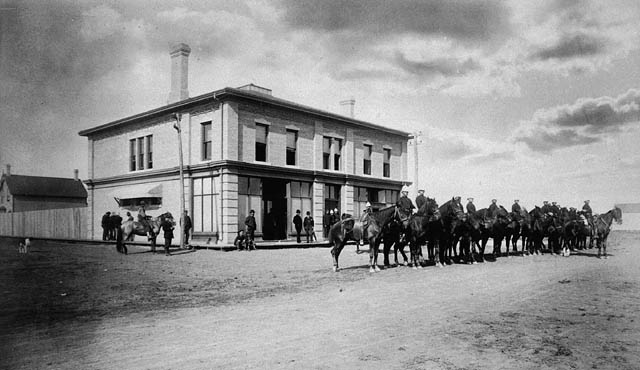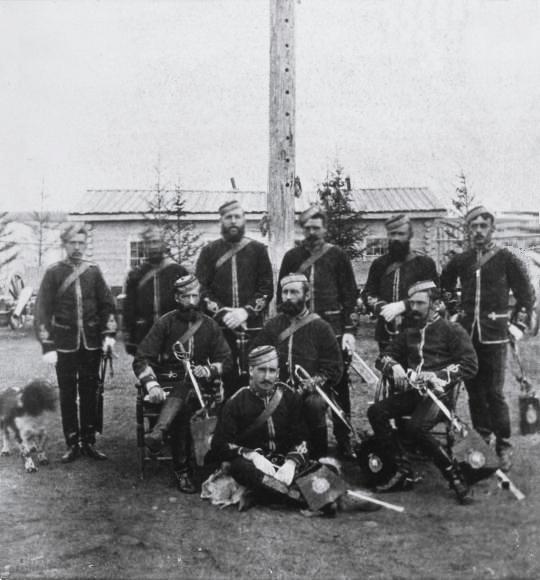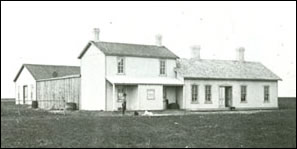|
Hayter Reed
Hayter Reed (May 26, 1849 – December 21, 1936) was a Canadian politician. He served on the 1st Council of the Northwest Territories. Early life Birth Hayter Reed was born in L'Orignal, Canada West, on 26 May 1849. His father was George Decimus Hayter, an immigrant from Surrey, England, a registrar for the United Counties of Prescott and Russell, who had married Hayter's mother, Harriet McKay, a Canadian born. Hayter Reed was one of two children; he had a sister named Louisa Reed. Family After Harriet McKay left George Decimus Reed, she travelled to the United States to live with her family. Harriet McKay took Louisa with her and left Hayter Reed with George Decimus Reed's sister's family, the Drapers. Thereafter George Decimus Reed died and Harriet McKay firmly eschewed any personal correspondence with Hayter Reed. Little else is known about George Decimus Reed, Harriet McKay, and Louisa Reed. Education With the support of his aunt and uncle, Hayter Reed attended U ... [...More Info...] [...Related Items...] OR: [Wikipedia] [Google] [Baidu] |
L'Orignal, Ontario
L'Orignal () is a Franco-Ontarian village and former municipality, now part of Champlain Township in eastern Ontario, Canada. Its population in 2016 was 1,450. L'Orignal likely took its name from its location on the Ottawa River once known as Pointe à l'Orignac ( French for "Moose Point"), where moose crossed the river. It was one of the seigneuries of New France. History In 1674, the Company of New France granted the Seigneurie de L'Orignac (later renamed the Seigneurie de Longueuil) to François Prévost. It was one of the two seigneuries the King of France granted in present-day Ontario, along with La Salle's Seigneurie de Cataraqui (now Kingston). As part of New France, the area was ceded to Great Britain in 1763. The seigneurie was assigned to Upper Canada (Ontario) during the creation of Upper Canada and Lower Canada (Quebec) in 1791. In 1798, Nathan Treadwell, of Plattsburgh, New York, purchased of seigneurial land. The government confiscated the property during th ... [...More Info...] [...Related Items...] OR: [Wikipedia] [Google] [Baidu] |
Clifford Sifton
Sir Clifford Sifton, (March 10, 1861 – April 17, 1929), was a Canadian lawyer and a long-time Liberal politician, best known for being Minister of the Interior under Sir Wilfrid Laurier. He was responsible for encouraging the massive amount of immigration to Canada which occurred during the first decade of the 20th century. In 1905, he broke with Laurier and resigned from cabinet over the issue of publicly funded religious education in the new provinces of Alberta and Saskatchewan. Early life Sifton was born in Middlesex County, Canada West (now Ontario). Sifton's father, John Wright Sifton, was a contractor and businessman who moved with his family to Manitoba when Sifton was a boy. Sifton trained as a lawyer and graduated from Victoria University in the University of Toronto, where he was the founding manager of ''Acta Victoriana''. Political career Manitoba provincial politics: Attorney General for Manitoba Sifton worked on his father's political campaigns before be ... [...More Info...] [...Related Items...] OR: [Wikipedia] [Google] [Baidu] |
1849 Births
Events January–March * January 1 – France begins issue of the Ceres series, the nation's first postage stamps. * January 5 – Hungarian Revolution of 1848: The Austrian army, led by Alfred I, Prince of Windisch-Grätz, enters in the Hungarian capitals, Buda and Pest. The Hungarian government and parliament flee to Debrecen. * January 8 – Hungarian Revolution of 1848: Romanian armed groups massacre 600 unarmed Hungarian civilians, at Nagyenyed.Hungarian HistoryJanuary 8, 1849 And the Genocide of the Hungarians of Nagyenyed/ref> * January 13 ** Second Anglo-Sikh War – Battle of Tooele: British forces retreat from the Sikhs. ** The Colony of Vancouver Island is established. * January 21 ** General elections are held in the Papal States. ** Hungarian Revolution of 1848: Battle of Nagyszeben – The Hungarian army in Transylvania, led by Josef Bem, is defeated by the Austrians, led by Anton Puchner. * January 23 – Elizabeth Blackwell is awarded her M.D. by the Medi ... [...More Info...] [...Related Items...] OR: [Wikipedia] [Google] [Baidu] |
Politicians In The Northwest Territories
A politician is a person active in party politics, or a person holding or seeking an elected office in government. Politicians propose, support, reject and create laws that govern the land and by an extension of its people. Broadly speaking, a politician can be anyone who seeks to achieve political power in a government. Identity Politicians are people who are politically active, especially in party politics. Political positions range from local governments to state governments to federal governments to international governments. All ''government leaders'' are considered politicians. Media and rhetoric Politicians are known for their rhetoric, as in speeches or campaign advertisements. They are especially known for using common themes that allow them to develop their political positions in terms familiar to the voters. Politicians of necessity become expert users of the media. Politicians in the 19th century made heavy use of newspapers, magazines, and pamphlets, as well ... [...More Info...] [...Related Items...] OR: [Wikipedia] [Google] [Baidu] |
Canadian Pacific Railway
The Canadian Pacific Railway (french: Chemin de fer Canadien Pacifique) , also known simply as CPR or Canadian Pacific and formerly as CP Rail (1968–1996), is a Canadian Class I railway incorporated in 1881. The railway is owned by Canadian Pacific Railway Limited, which began operations as legal owner in a corporate restructuring in 2001. Headquartered in Calgary, Alberta, the railway owns approximately of track in seven provinces of Canada and into the United States, stretching from Montreal to Vancouver, and as far north as Edmonton. Its rail network also serves Minneapolis–St. Paul, Milwaukee, Detroit, Chicago, and Albany, New York, in the United States. The railway was first built between eastern Canada and British Columbia between 1881 and 1885 (connecting with Ottawa Valley and Georgian Bay area lines built earlier), fulfilling a commitment extended to British Columbia when it entered Confederation in 1871; the CPR was Canada's first transcontinental railway. ... [...More Info...] [...Related Items...] OR: [Wikipedia] [Google] [Baidu] |
Regina, Saskatchewan
Regina () is the capital city of the Provinces and territories of Canada, Canadian province of Saskatchewan. The city is the second-largest in the province, after Saskatoon, and is a commercial centre for southern Saskatchewan. As of the 2021 Canadian census, 2021 census, Regina had a List of cities in Saskatchewan, city population of 226,404, and a List of census metropolitan areas and agglomerations in Canada, Metropolitan Area population of 249,217. It is governed by Regina City Council. The city is surrounded by the Rural Municipality of Sherwood No. 159. Regina was History of Northwest Territories capital cities, previously the seat of government of the Northwest Territories, North-West Territories, of which the current provinces of Saskatchewan and Alberta originally formed part, and of the District of Assiniboia. The site was previously called Wascana ("Buffalo Bones" in Cree), but was renamed to Regina (Latin for "Queen") in 1882 in honour of Queen Victoria. This decisio ... [...More Info...] [...Related Items...] OR: [Wikipedia] [Google] [Baidu] |
North-West Mounted Police
The North-West Mounted Police (NWMP) was a Canadian para-military police force, established in 1873, to maintain order in the new Canadian North-West Territories (NWT) following the 1870 transfer of Rupert’s Land and North-Western Territory to Canada from the Hudson’s Bay Company, the Red River Rebellion and in response to lawlessness, demonstrated by the subsequent Cypress Hills Massacre and fears of United States military intervention. The NWMP combined military, police and judicial functions along similar lines to the Royal Irish Constabulary. A small, mobile police force was chosen to reduce potential for tensions with the United States and First Nations in Canada, First Nations. The NWMP uniforms included red coats deliberately reminiscent of British and Canadian military uniforms. The NWMP was established by the Canadian government during the ministry of Prime Minister of Canada, Prime Minister Sir John A. Macdonald, John Macdonald who defined its purpose as "the pres ... [...More Info...] [...Related Items...] OR: [Wikipedia] [Google] [Baidu] |
Pass System (Canadian History)
The pass system (1885–1951) was a Canadian federal government Department of Indian Affairs (DIA) segregationist policy, first initiated on a significant scale in the region that became the three prairie provinces in the wake of the 1885 North-West Rebellion—as part of a series of highly restrictive measures—to confine Indigenous people to Indian reserves—newly-established through the numbered treaties. The "Indian pass system"—introduced as a temporary emergency measure to quell First Nations resistance—was formalized and became permanent under successive federal governments. In archived correspondence between the three federal officials who were the "most prominent in the development and implementation of Indian policy" in the 1880s and 1890s—John A. Macdonald (1815–1891), Edgar Dewdney (1835–1916), and Hayter Reed (1849–1936), it was evident that they were all cognizant of the lack of a legal basis for the pass system, and that it did not respect treaty agre ... [...More Info...] [...Related Items...] OR: [Wikipedia] [Google] [Baidu] |
Google Books
Google Books (previously known as Google Book Search, Google Print, and by its code-name Project Ocean) is a service from Google Inc. that searches the full text of books and magazines that Google has scanned, converted to text using optical character recognition (OCR), and stored in its digital database.The basic Google book link is found at: https://books.google.com/ . The "advanced" interface allowing more specific searches is found at: https://books.google.com/advanced_book_search Books are provided either by publishers and authors through the Google Books Partner Program, or by Google's library partners through the Library Project. Additionally, Google has partnered with a number of magazine publishers to digitize their archives. The Publisher Program was first known as Google Print when it was introduced at the Frankfurt Book Fair in October 2004. The Google Books Library Project, which scans works in the collections of library partners and adds them to the digital invent ... [...More Info...] [...Related Items...] OR: [Wikipedia] [Google] [Baidu] |
Edgar Dewdney
Edgar Dewdney, (November 5, 1835 – August 8, 1916) was a Canadian surveyor, road builder, Indian commissioner and politician born in Devonshire, England. He emigrated to British Columbia in 1859 in order to act as surveyor for the Dewdney Trail that runs through the province. In 1870, Dewdney decided to take up a role in Canadian government. In this year, he was elected to the Legislative Council of British Columbia as a representative form the Kootenay region. In 1872, he was elected as a member of Federal Government for the Yale region representing the Conservative party. He was reelected to this position in 1874 and again in 1878. Dewdney served as Lieutenant Governor of the North-West Territories from 1879 to 1888, and the fifth Lieutenant-Governor of British Columbia from 1892 to 1897. Additionally, he served as the Indian commissioner in the North-West Territories from 1879 until 1888. In 1897, Dewdney retired from politics and began working as a financial agent until ... [...More Info...] [...Related Items...] OR: [Wikipedia] [Google] [Baidu] |
Canada West
The Province of Canada (or the United Province of Canada or the United Canadas) was a British colony in North America from 1841 to 1867. Its formation reflected recommendations made by John Lambton, 1st Earl of Durham, in the Report on the Affairs of British North America following the Rebellions of 1837–1838. The Act of Union 1840, passed on 23 July 1840 by the British Parliament and proclaimed by the Crown on 10 February 1841, merged the Colonies of Upper Canada and Lower Canada by abolishing their separate parliaments and replacing them with a single one with two houses, a Legislative Council as the upper chamber and the Legislative Assembly as the lower chamber. In the aftermath of the Rebellions of 1837–1838, unification of the two Canadas was driven by two factors. Firstly, Upper Canada was near bankruptcy because it lacked stable tax revenues, and needed the resources of the more populous Lower Canada to fund its internal transportation improvements. Secondly, ... [...More Info...] [...Related Items...] OR: [Wikipedia] [Google] [Baidu] |
Battleford
Battleford ( 2011 population 4,065) is a small town located across the North Saskatchewan River from the City of North Battleford, in Saskatchewan, Canada. Battleford and North Battleford are collectively referred to as "The Battlefords" by Saskatchewan residents, as well as on highway signage. Although there has been occasional talk of the two communities merging, as of 2012 they remain separate entities. The local economy is fuelled mainly by agriculture. Battleford is bordered by the Rural Municipality of Battle River No. 438, as well as by the city of North Battleford and a small section of the Rural Municipality of North Battleford No. 437. The 1973 western ''Alien Thunder'' was partially filmed in Battleford. History The Battleford area was the site of numerous independent and Hudson's Bay Company fur trading houses dating from the 1770s. William Holmes operated a post for the North West Company just above the confluence of the Battle and Saskatchewan rivers in 1784. ... [...More Info...] [...Related Items...] OR: [Wikipedia] [Google] [Baidu] |






